Samsung Galaxy Note 3 review
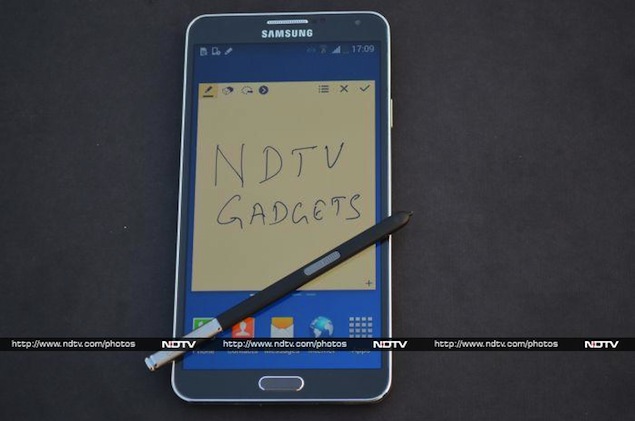
Samsung created a new category when it launched the Galaxy Note. While naysayers were initially critical of its ungainly size, it did manage to attract a large number of consumers who were looking for a device that integrated the big screen of a tablet with the portability and convenience of a smartphone. It even inspired other device makers to launch similar devices, though it's been hard for them to offer a differentiating feature.
The Galaxy Note's strength is the S Pen, the intelligent stylus that accompanies the device and allows users to do more than just navigate the user interface and scribble notes. With the Note 3, Samsung claims to take the experience at the next level. We try to find out if its still the best phablet in the market, in our review.
Build/ Design
The Samsung Galaxy Note 3 retains the same design that gave the Note series of smartphones their own identity. When we first lay our hands on the phone, it reminded us of the original Note. The Note 3 looks much more similar to the first-generation Note than the Note II, which was more curved.
The Note 3 is essentially made of plastic but Samsung has cleverly disguised the finish of certain elements to give the smartphone a premium fit and finish. Despite its huge size, the phone doesn't feel heavy and fits in the pocket in a better manner, if you compare it with the Sony Xperia Z Ultra. Having said that, it's still ungainly when it comes to singe-handed operation, though Samsung has tried to find a solution for it.
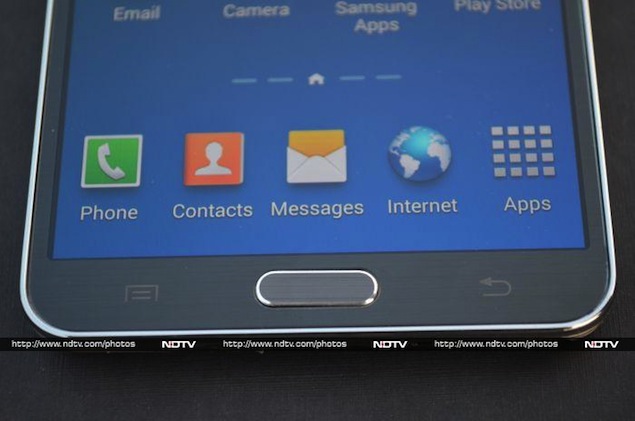 The
Note 3 is available in three colours - Jet Black, Classic White, and
Blush Pink, and we got a Jet Black phone as our review unit.
The
Note 3 is available in three colours - Jet Black, Classic White, and
Blush Pink, and we got a Jet Black phone as our review unit.The front of the phone is dominated by its 5.7-inch Full-HD Super AMOLED display. The bezel is narrow on the left and right sides and unlike the Galaxy Note II, the Galaxy Note 3 is not beveled above and below the screen and is flatter, sporting a textured dark grey finish.
The front of the phone still features a physical Home button and two capacitive touch buttons for Menu and Back controls. The different sensors, front camera, notification light and earpiece grill sit above the Note 3's screen.
The phone's front panel is surrounded by a chrome frame, which gives a premium feel to the Galaxy Note 3, but the edges sport a faux-metal finish with a ribbed pattern.
The power button is on the right edge of the Note 3, volume rocker on the left, a 3.5mm headset jack and Infrared receiver on the top and a new USB 3.0 port sits at the bottom aloneg with a small speaker grill and the slot for the S-Pen stylus. It's good that Samsung has placed the power button on the side and not on the top, in line with other large screen phones, but if you have small hands you'll still find the location a little cumbersome.
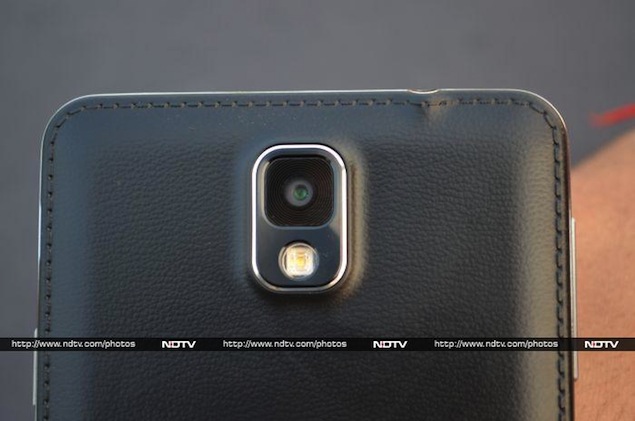 The
back of the Galaxy Note 3 is another place where Samsung has made some
major changes to give the phone a refined look. It sports a leather
finish, complete with the stitching, and we'll have to say that it looks
really close to the real thing and Samsung deserves some credit.
The
back of the Galaxy Note 3 is another place where Samsung has made some
major changes to give the phone a refined look. It sports a leather
finish, complete with the stitching, and we'll have to say that it looks
really close to the real thing and Samsung deserves some credit.The back also features the 13-megapixel-camera lens, with the LED flash right below it. The Indian version of the Note 3 just features the Samsung branding at the back. There's a small speaker outlet towards the bottom.
The back is removable and hides the micro-SIM card and microSD card slots that are stacked on top of each other, and the battery. Samsung has been able to please people who advocate the use of a removable battery and memory card slot, once again.
Overall, the Note 3 looks much more refined than the Note II with its leather finish back and good weight to dimensions ratio, though it still sports the same design.
Display
As we mentioned, the Galaxy Note 3 is in a way Samsung's other flagship device, other than the Galaxy S4. All flagship devices now tick the full-HD display checkmark, and keeping with the trend, Samsung has also upgraded the screen to full-HD. The screen's also bigger by 0.2-inches at 5.7-inches.
The Galaxy Note 3 comes with a full-HD Super AMOLED display with a resolution of 1080x1920 pixels packing 386 pixels per inch.
The Galaxy Note 3's display, is among the best displays we've seen so far. In our use, we found that text, images and videos appear extremely sharp, with vibrant colours. Reading text and browsing the web was also a pleasant experience.
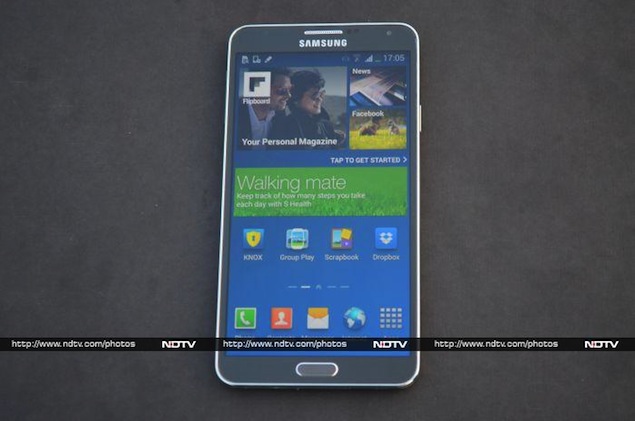 The
only downside to the display is that colour reproduction is not very
accurate, and as with other AMOLED displays, they appear a bit
oversaturated.
The
only downside to the display is that colour reproduction is not very
accurate, and as with other AMOLED displays, they appear a bit
oversaturated. Just like the Galaxy S4, Samsung offers what it calls Adapt Display, to optimise colours according to ambient light conditions. You can choose between four manual modes (Dynamic, Standard, Professional Photo and Movie) and automatic modes if you select the Adapt Display option. The phone also offers the option to adjust the screen tone automatically to conserve battery power.
The display was not very reflective and sunlight legibility was great. The viewing angles on the phone are excellent.
The Note 3's big full-HD display enhances the user experience by leaps and bounds.
Software / User Interface
The Samsung Galaxy Note 3 runs Android 4.3 Jelly Bean, the latest iteration of the OS (at the time of writing this review) and TouchWiz Nature UX, Samsung's own UI that includes custom apps in addition to a skinned interface.
While some people prefer stock Android to any kind of skinning, Samsung's TouchWiz UI has been panned for employing big, glossy and cartoon-like icons and menus. The intent might be to make the UI user-friendly, but it ends up looking anything but pleasant. The Galaxy Note 3's UI has been optimised for the S Pen, a stylus that offers enhanced functionality with the device's built-in digitiser.
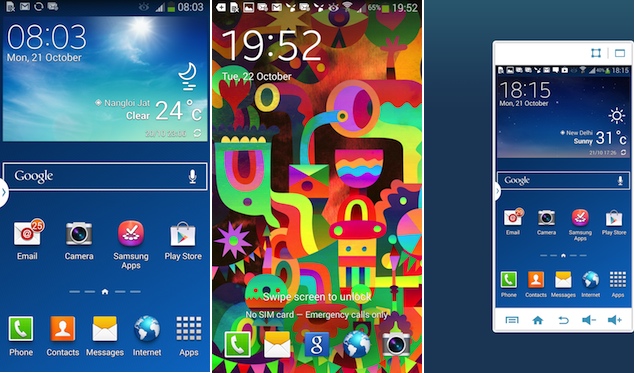 The
Touchwiz UI add-ons on the Note 3 are similar to that of the Samsung
Galaxy S4 and you can read more about them in our Galaxy S4 review.
The
Touchwiz UI add-ons on the Note 3 are similar to that of the Samsung
Galaxy S4 and you can read more about them in our Galaxy S4 review.The Samsung Galaxy Note 3 offers a more enhanced version of Multi-window that comes with support for launching two instances of the same app. It's also been made more flexible as you can place the Multi-window bar on either side of the screen.
It also offers a new Magazine screen which can be launched by simply flipping the Home screen towards the top. The Note 3 takes a cue from HTC's BlinkFeed notifications screen and allows users to read News across categories, personal content and social network feeds on the Home screen in a magazine like format. It's an alternate home screen as it offers shortcuts for launching apps like the Phone dialler, SMS and Camera, among others.
Just like the previous versions of the Galaxy Note, the Note 3 also features 'one-handed operation' settings allowing users to position not just the keypad and in-call buttons, calculator and screen unlock pattern on the left or right side, as per their convenience, but also shrink the entire interface to one's liking by an awkward left and right swipe gesture. One can resize the interface window to one's liking and Samsung even offers virtual on-screen Menu, Home, Back and Volume control keys. This is a great feature for people who find the screen too big for daily use.
Just like the Galaxy S4, the Note 3 features motion and gesture-driven controls. The gestures include Quick Glance that lets you glance at information like missed calls, time and unread message count when you move your hand over the phone; Air Jump that lets you move up and down web pages and emails when you move your hands, and Air Browse to essentially browse the Gallery, web pages, music tracks and memo notes, and even accept calls with the wave of your hand.
Another similar feature is Air View that lets you preview text inside emails and SMS or images inside a folder when you hover your finger or the S Pen over the screen. This even works for speed-dial contacts, to view Icon labels, scrolling lists and for tracking progress bars while watching videos. You can choose to either use your finger or the -Pen or automatically switch to whichever one it detects.
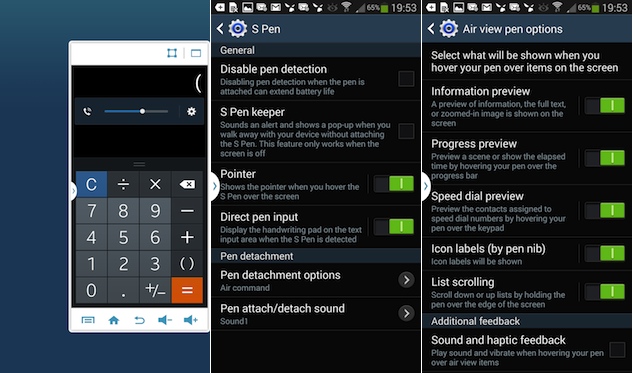 The
major feature of the Note 3 that integrates the S Pen is Air Command.
The -Pen that comes with the Note 3 features a button that can be
pressed to invoke an Air Command menu on the screen when you hover it
over the screen. The Air Command menu brings Action Memo, Scrapbooker,
Screen Write, S Finder and Pen Window options. One can also insert
content, and contacts and view additional options while hovering the S
Pen around the display and pressing the button on the S Pen. It does
make things a bit complicated but if you're someone who loves to create
content and share it in a jiffy, you might like this feature. We found
the additional S Pen button shortcut features a bit overwhelming though.
The
major feature of the Note 3 that integrates the S Pen is Air Command.
The -Pen that comes with the Note 3 features a button that can be
pressed to invoke an Air Command menu on the screen when you hover it
over the screen. The Air Command menu brings Action Memo, Scrapbooker,
Screen Write, S Finder and Pen Window options. One can also insert
content, and contacts and view additional options while hovering the S
Pen around the display and pressing the button on the S Pen. It does
make things a bit complicated but if you're someone who loves to create
content and share it in a jiffy, you might like this feature. We found
the additional S Pen button shortcut features a bit overwhelming though.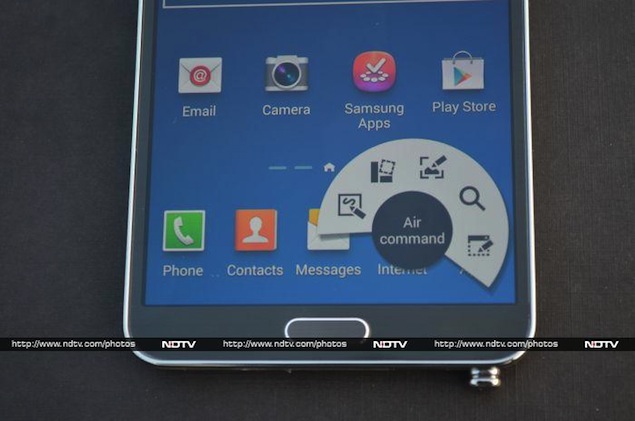 Elaborating
on the Air Commands on the Note 3, the Action Memo lets you jot down
things and turn them into actionable items. For instance, you can jot
down a number and save it or call it through the Memo.
Elaborating
on the Air Commands on the Note 3, the Action Memo lets you jot down
things and turn them into actionable items. For instance, you can jot
down a number and save it or call it through the Memo.The 'Scrapbooker' Air Command feature lets you add content from the screen including pictures and YouTube videos and put additional notes. The Screen Write function lets you write free hand on the screen, while the S Finder lets you browse content created with the S Pen and comes with predefined filters. In our use on the Note 3 it was able to search notes for words and symbols.
The 'Pen Window' Air Command on the Note 3 allows you to draw a box and invoke an app allowing you to multitask. You can even watch two YouTube videos through this feature.
Samsung offers S Pen apps like the S Note (for jotting notes), SketchBook (an optional download that offers tools for drawing) and Scrapbook to compile content in a scrapbook format on the Note 3
The Note 3 also has 'Smart Screen' features including Smart Stay, which keeps the screen on as long as you're looking at it; Smart Pause that pauses a running video when you look away, and Smart Scroll that scrolls webpages or emails according to the angle at which you tilt your head or the phone.
Motion commands included on the Note 3 allow you to tilt your phone to zoom in while looking at an image. or turn over the phone to mute while receiving a call.
The Galaxy Note 3 also offers voice commands for accepting and rejecting calls, taking pictures and controlling music. In our use we observed that it worked intermittently.
Samsung also offers some of its pre-loaded apps including S Planner, Voice Recorder, ChatOn messaging app, Samsung Apps app store, Samsung Hub content store, Samsung Link for transferring and syncing content to other devices via cloud services like Dropbox, WatchON - a universal remote control software that also offers program guide functionality, S Translator, Optical Reader, S Memo, S Health, Story Album and Group Play. You can read more about these apps in our Galaxy S4 review.
Camera
The Galaxy Note 3 features a 13-megapixel rear camera that takes excellent shots in daylight and good artificial light. We found that pictures clicked with the phone had good amount of detail and looked very close to life with accurate colour reproduction. We found pictures shot with the Note 3's camera to be a little better than the ones shot with the Galaxy S4.
Low-light shots are an area of weakness. Pictures come out distorted and noisy if it's too dark. Strangely, Samsung has not included a Night Mode setting in the phone's camera app. The phone can't match the low-light performance of the HTC One and the iPhone 5.
The Galaxy Note 3's 2-megapixel front camera does a decent job when it comes to video chats but pictures taken indoors were grainy at times.
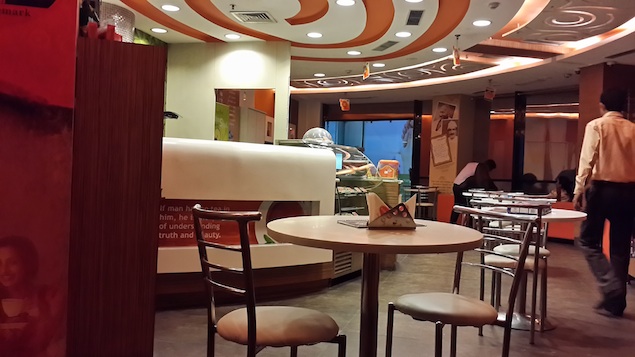 The
Note 3's rear camera is capable of recording 1080p video and performs
well. It can also capture Slow motion, Fast motion and Smooth motion
videos. It also offers video stabilisation to let you take steady shots.
The phone's rear camera performs well in the video capture department.
It's worth pointing out that unlike the Snapdragon 800 variant of the
Note 3, the Exynos 5 Octa-version sold in India does not offer support
for 4K video recording.
The
Note 3's rear camera is capable of recording 1080p video and performs
well. It can also capture Slow motion, Fast motion and Smooth motion
videos. It also offers video stabilisation to let you take steady shots.
The phone's rear camera performs well in the video capture department.
It's worth pointing out that unlike the Snapdragon 800 variant of the
Note 3, the Exynos 5 Octa-version sold in India does not offer support
for 4K video recording.The Galaxy Note 3 also adds the Galaxy S4's new camera tricks including Cinemagram like Animated photo mode; an Eraser mode to delete moving objects from 5 consecutive photos; Drama shot, which takes multiple photos of a moving object and merges them all to denote action; and Best face, which allows selecting the best face shot in group photos, in addition to the usual Burst mode that takes 20 continuous shots, and HDR mode and Panorama mode. It also allows you to shoot through both the front and rear lenses simultaneously and put a stamp-sized photo of yours in a photo that you're clicking with the rear camera.
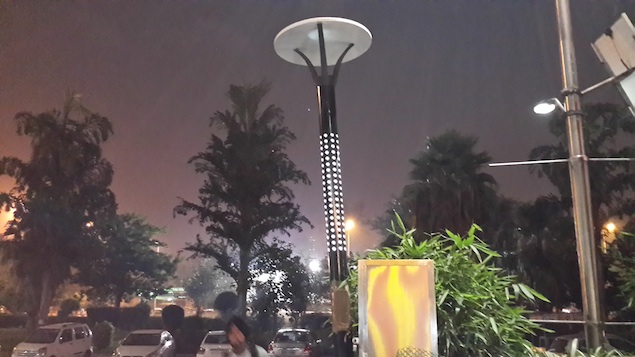 You're not likely to find all of these tricks useful in the long run, though.
You're not likely to find all of these tricks useful in the long run, though.Performance/ Battery Life
The Samsung Galaxy Note 3 is powered by Samsung's Exynos 5 Octa 5420 processor which is essentially a set of two quad-core processors- a 1.9GHz Cortex A15 quad-core processor and a 1.3GHz Cortex A7 quad-core processor that work together to optimise processing. It has 3GB RAM onboard, and a Mali T628 MP6 chip for processing graphics. Our review unit had 32GB of expandable built-in storage, out of which 24GB was available for our use.
With Android 4.3 Jelly Bean, the overall experience of navigation through the interface was extremely impressive, thanks to all the power under the hood. We did not experience any lag at all on the Note 3. We had no issue while launching apps, playing games, scrolling web pages or switching between apps. Performance wise the Galaxy Note 3 is a power horse, compared to the other Android flagships in the market at this point in time.
The Galaxy Note 3 offers Chrome in addition to the default browser. The default browser does not offer Adobe flash. It also offers a reader mode for reading text heavy web pages.
We were able to play full-HD clips on the Note 3, though some formats including .mov, were not supported natively (this was easily fixed by the use of third party apps). The speaker outlet on the phone delivers good quality sound at average volume levels.
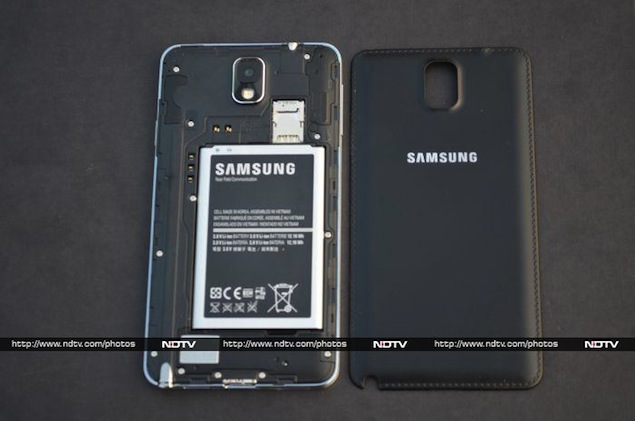 Call quality on the Note 3 was great, and the phone is able to latch on to cellular networks even in weak signal areas.
Call quality on the Note 3 was great, and the phone is able to latch on to cellular networks even in weak signal areas. Notably, the Galaxy Note 3 lacks FM radio functionality, which will surely disappoint many, especially in our Indian audience.
The Samsung Galaxy Note 3 comes with a 3200mAh battery, and in our usage, it lasted us a full workday. We charged the phone in the morning (at around 9AM), and with medium to heavy usage, including 1-1.5 hours of phone calls, two email accounts with push notifications, playing some music, taking some photographs, Twitter notifications and WhatsApp chats, the phone lasted a good 9-10 hours. It's worth pointing out that we had turned off Wi-Fi and auto-brightness, and the phone was hooked to a 3G network with the screen brightness at the highest level. Altering these settings might help in running the phone for a longer duration, depending on your usage pattern.
Verdict
The Galaxy Note 3 is indeed the best big screen phone or phablet available in the market, at this point in time. It packs in the latest hardware, a brilliant full-HD screen, better build quality and a smart stylus that makes multi-tasking a breeze. At a price of Rs. 49,900, the Galaxy Note 3 offers almost every imaginable feature that a modern smartphone could offer. But is it really for you?
If you're looking for a big screen high-end smartphone and only want to settle with nothing but the latest hardware, the Note 3 is a great device. It makes even more sense if you like scribbling notes, collecting and organising content that you come across, or doodling, in other words, going beyond just pure content consumption. The S Pen's Air Commands also take interaction with the features and UI of the phone, to the next level.
 We're
a bit disappointed that Samsung chose to offer the Exynos version of
the Note 3 instead of the Snapdragon 800 one, as it misses out on 4K
video recording which would have made the phone future proof for at
least some time.
We're
a bit disappointed that Samsung chose to offer the Exynos version of
the Note 3 instead of the Snapdragon 800 one, as it misses out on 4K
video recording which would have made the phone future proof for at
least some time.If you're fine with last year's hardware and don't want to shell out a lot of money, the Note II is still available, and with the software updates, offers a good phablet experience. Other devices you can look at include the Sony Xperia Z Ultra, though it doesn't offer a good camera (lacks LED flash as well) experience and feels a little awkward to carry due to its dimensions to weight ratio.
Price: Rs. 49,900
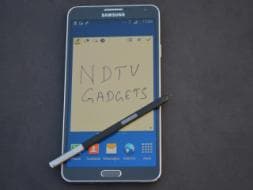
Samsung Galaxy Note 3 in pictures
Pros
- Brilliant HD screen
- Excellent performance
- Latest OS version
- Options for easy single-handed operation
Cons
- No FM radio
- No 4K video recording
- Expensive
- Bad low light photography
Ratings (Out of 5)
Design: 4
Display: 4.5
Performance: 4.5
Software: 4
Battery Life: 3.5
Value for Money: 3.5
Camera: 4
Overall: 4







 .
.
0 comments:
Post a Comment